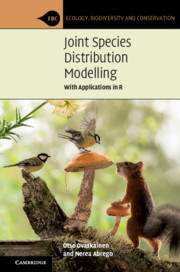Description
Joint Species Distribution Modelling
With Applications in R
Ecology, Biodiversity and Conservation Series
Authors: Ovaskainen Otso, Abrego Nerea
A comprehensive account of joint species distribution modelling, covering statistical analyses in light of modern community ecology theory.
Language: English
Subject for Joint Species Distribution Modelling:
Approximative price 48.38 €
In Print (Delivery period: 14 days).
Add to cart
Joint Species Distribution Modelling
Publication date: 06-2020
388 p. · 15.3x22.8 cm · Paperback
Publication date: 06-2020
388 p. · 15.3x22.8 cm · Paperback
Approximative price 121.50 €
In Print (Delivery period: 14 days).
Add to cart
Joint Species Distribution Modelling
Publication date: 06-2020
388 p. · 15.6x23.5 cm · Hardback
Publication date: 06-2020
388 p. · 15.6x23.5 cm · Hardback
Description
/li>Contents
/li>Biography
/li>
Joint species distribution modelling (JSDM) is a fast-developing field and promises to revolutionise how data on ecological communities are analysed and interpreted. Written for both readers with a limited statistical background, and those with statistical expertise, this book provides a comprehensive account of JSDM. It enables readers to integrate data on species abundances, environmental covariates, species traits, phylogenetic relationships, and the spatio-temporal context in which the data have been acquired. Step-by-step coverage of the full technical detail of statistical methods is provided, as well as advice on interpreting results of statistical analyses in the broader context of modern community ecology theory. With the advantage of numerous example R-scripts, this is an ideal guide to help graduate students and researchers learn how to conduct and interpret statistical analyses in practice with the R-package Hmsc, providing a fast starting point for applying joint species distribution modelling to their own data.
Part I. Introduction to Community Ecology: Theory and Methods: 1. Historical development of community ecology; 2. Typical data collected by community ecologists; 3. Typical statistical methods applied by community ecologists; 4. An overview of the structure and use of HMSC; Part II. Building a Joint Species Distribution Model Step by Step: 5. Single-species distribution modelling; 6. Joint species distribution modelling: variation in species niches; 7. Joint species distribution modelling: biotic interactions; 8. Bayesian inference in HMSC; 9. Evaluating model fit and selecting among multiple models; Part III. Applications and Perspectives: 10. Linking HMSC back to community assembly processes; 11. Illustration of HMSC analyses: case study of Finnish birds; 12. Conclusions and future directions; Epilogue; Index; References.
Otso Ovaskainen is Professor of Mathematical Ecology at the University of Helsinki, Finland. He has published 170 papers in mathematical, statistical and empirical ecology, with a particular focus on metapopulation ecology, movement ecology, population genetics, molecular species identification and community ecology.
Nerea Abrego is a post-doctoral researcher at the University of Helsinki. After obtaining her Ph.D. in fungal ecology, she expanded her research to genera community ecology. She has published thirty papers, many of which relate to recent developments in joint species distribution modelling.
Nerea Abrego is a post-doctoral researcher at the University of Helsinki. After obtaining her Ph.D. in fungal ecology, she expanded her research to genera community ecology. She has published thirty papers, many of which relate to recent developments in joint species distribution modelling.
© 2024 LAVOISIER S.A.S.




